

A friend of mine here in Bangkok bought this old Seiko during a recent visit to his hometown of Nan, about 450 miles north of Bangkok, for 500 baht (around US$12.50). Not really a lot for a watch which is still quite handsome, despite its well-aged dial and fairly worn case (though 500 baht can be a lot of money to many Thai people, my friend included). This watch had clearly been a real workhorse in its lifetime. The case style, dial and chapter ring are somewhat reminiscent of Accutron 214's from the 60's, so I instantly took a liking to it. Anyway, he complained that it "doesn't keep good time and keeps stopping". Thinking about that, I would have to say that most watches I ever came across that stopped, didn't keep good time! Maybe a watch collector in a western country may not consider it worth the effort to repair, but here things are different, so onto the workbench it went for an overhaul.
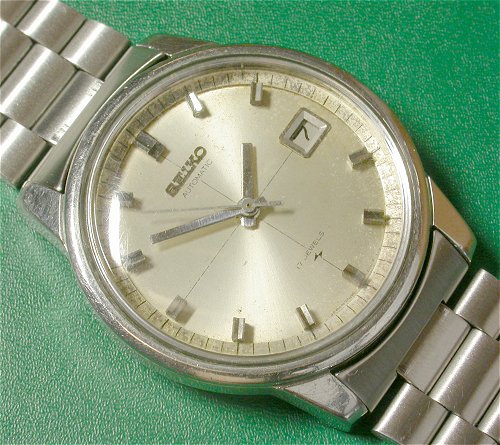
I have only lived here in Thailand for about 18 months so far, and have found that by and large, watches are not treated well here by repairers - especially secondhand watches. Many of the big brand names have workshops here doing their own warranty servicing, but for ordinary old watches, the prognosis is not too good. I don't believe there is very much formal training in watch repairing available in this country, unfortunately. My first "warning sign" about horology here was the lack of availability of high-quality waterless ultrasonic cleaning solutions, only a locally made water-based brew. Well, I admit that it does the job quite well anyway with the right selection of rinsing baths, but I still prefer waterless. While parts shops sell a good range of Bergeon tools, many local repairers cannot afford them. I have seen watch sellers at markets repairing watches using tools from car repair tool kits, and even opening watch cases with hammers and chisels no less. So I was prepared to expect anything when I opened this watch, though perhaps it was not quite as bad as expected.
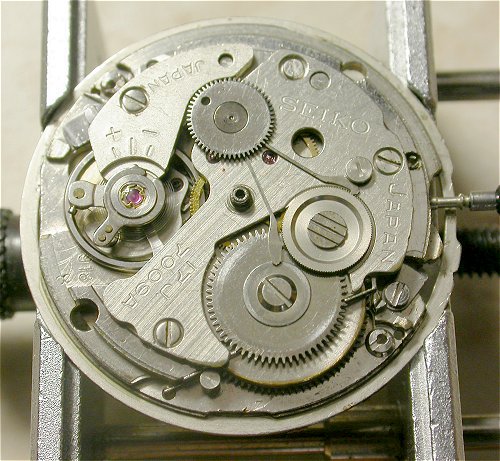 |
The first problem was removing the dial...the dial pins had been sheared off, and the dial and dial spacer ring had been glued to the movement using contact cement. Glue is a very common repair material here. This pic shows the movement, with the dial and auto winding weight removed. The dial support ring is still firmly glued to the pillar plate. Well, first of all, it can be seen that the top plate is marked as a 7009A, not the expected 7005. Consulting the Seiko parts catalogs revealed that the cals 7002, 7005 7006 and 7009 are almost identical, sharing many parts in common. The main difference is in thickness, day/date features and jewelling. The 7005 is date only, the 7009 is a day/date and the 7002A is date only and has a different auto winding weight. Since this particular movement is a "date only", then one concludes it started life as a 7005A, to be transfomed at a later date by whatever parts were to hand at the time. So this movement is a bit of a "frankenwatch" to begin with....but no matter. Apparent also was the somewhat eclectic assortment of screws used on the bridges - anything that fitted was used, regardless of origin. No worries, easily fixed later. |
Since we are servicing a 7005, a good opportunity exists to compare this movement to the 7s26, which along with the 7s36, is the latest incarnation of the 7005 series. The 7s26 and 36 are found in the current range of Seiko 5 mechanical watches. Comparing it to the 7005 above, its lineage is more than a bit obvious. There are some differences in design of the keyless works and the calendar mechanism. In my opinion, the calendar mechanism of the 7005/9 watches is superior in design and construction. Also, despite the extra jewels (4) of the 7s26, the overall quality of finish is substantially lower than its predecessors. Seiko has made no attempt whatsoever at any decorative finishing of the plates, only finishing or polishing mechanical working surfaces where functionality requires. |
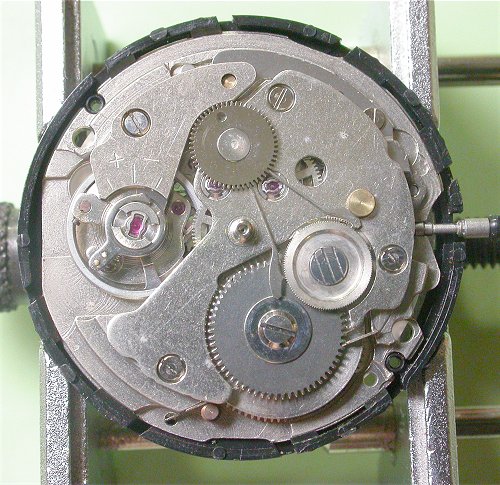 |
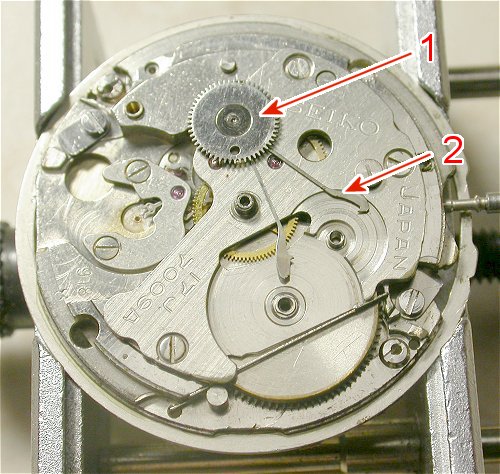 |
Getting back to the 7005, we see that the balance and the second reduction wheel have been removed in this pic. The double pawl lever (the "Magic Lever") can be seen. This is driven in an oscillating motion by an eccentric cam under the first reduction wheel. Little hooks on the ends of the levers pull on ratchet teeth on the second reduction wheel, one pushing and one pulling, causing it to rotate in only one direction. I am sure that Seiko's incredibly simple and efficient bi-directional auto winding mechanism is one of the keys to the great success of the company. This system is used in all their autos, at least from the 6xxx series onwards. Why no-one thought of this system before seems hard to imagine. Its simplicity to manufacture and service seems all the more apparent when one compares it with the Eterna system as used on 2824's etc, not to mention the many other over-complicated systems that have been used over the years by lots of makers. See Note 1 below. I am sure that many watch designers in Switzerland didn't get christmas bonuses the year Seiko introduced the Magic Lever system!
|
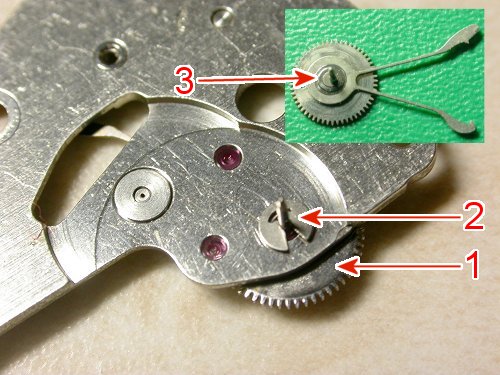 |
A view of the top plate from the under side. Here the "c" clip which secures the first reduction wheel can be seen. The inset shows the eccentric cam under the first reduction wheel.
|
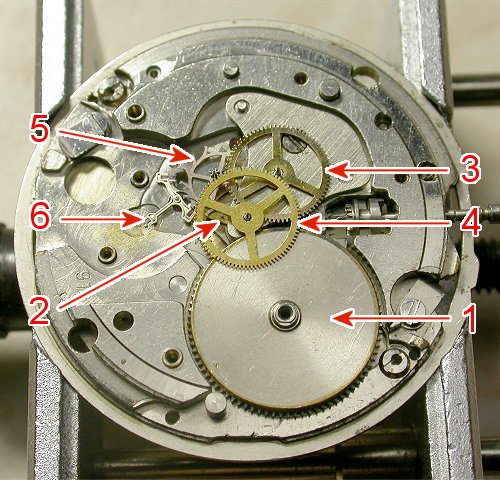 |
With the top plate removed, we can see that the movement is a direct seconds design. In other words, power to the escapement flows from the mainspring, to the center wheel, then third wheel, through the sweep second wheel (in the center), and then on to the escape wheel. In an indirect-seconds design, the seconds hand is not in the flow of power, but "hangs off the side" of the train, so to speak.
|
A quick look at the balance wheel. Though this balance has spokes that indicate it is glucydur, I am not sure if it is, though it could be a similar alloy as these movements perform very well. The diameter is 9.25mm, quite a reduction in size from the 5 and 6xxx movements which had huge 11.0 and 11.7mm diameter balances. Perhaps Seiko determined the reduction in balance diameter to gain some room was worth the compromise in (possibly) slightly reduced accuracy. The balance spring is pinned at the stud in the traditional way, while the other end of the spring is crimped into a groove machined in the small sector of the roughly triangular collet. This neat tangential method of terminating the spring results in there being much less stress on it than in a pinned collet where the spring has to do a 90 degree bend after exiting the collet, and more or less automatically makes the spring run concentric to the balance - very important for accurate positional adjustment. |
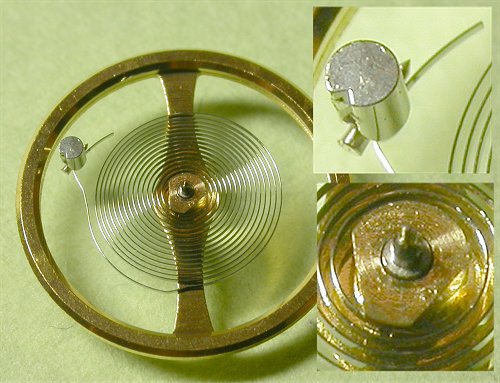
|
Since we are talking about balances now, why not take a look at the business end of the balance ie the balance cock. Seiko employed an adjustable stud carrier, allowing the watch to be set into beat very easily (with a timing machine). Actually, an adjustable stud is really necessary in this series of movements, as the solid brass balance spring collet is pressed very tightly onto the balance staff, and not easily removable or adjustable. The index is an enclosed type, which stops the spring from jumping out of the index pins if the watch is knocked hard (inset shows the index in "open" position). Lastly, the movement employs Seiko's "Diashock" shock protection system on the balance pivots. Like other systems, it consists of a chaton (carrier) which holds a hole jewel and cap jewel. This is spring loaded into a setting by the star-shaped spring visible on the top. Seiko's Diashock settings of this design are very easy to disassemble and reassemble for cleaning. Later rectangular versions, as used in the 7s26, are not so convenient. |

|
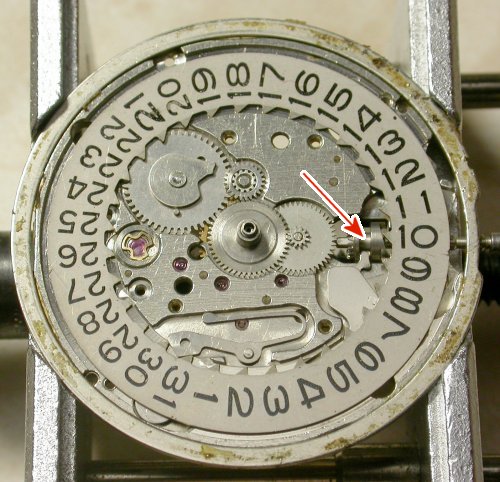 |
The movement from the dial side with the date dial guard removed. Again, if one was previously impressed by the auto winding system, one is equally impressed with the simplicity and robustness of the calendar mechanism. There are only 5 moving parts including the date ring itself and the detent spring for the calendar, plus 1 more part for quick-setting the date. Because these Seiko calibres do not employ manual winding, the clutch wheel (arrowed) has been cleverly used as a means of quick setting the date. In the quick-set position of the crown, teeth on the clutch wheel engage directly with the teeth on the date ring. It could not possibly be simpler! |
Again, we will pause briefly to compare the 7005 movement to a 7s26. This pic of the 7s26 shows the day ring removed. Both the day and date rings are plastic (in the 7005 they were metal), as are the 2 white corrector wheels for the day and date, and the 2 wheels driving the date ring. Also, the detents and springs for the day and date wheels are made as an integral part of the date jumper plate and dial guard, rather than as separate components (in this pic, only the day detent is visible). Being stamped from brass shim instead of the traditional steel, they are quite flimsy and prone to distortion if not handled carefully during service. |
 |
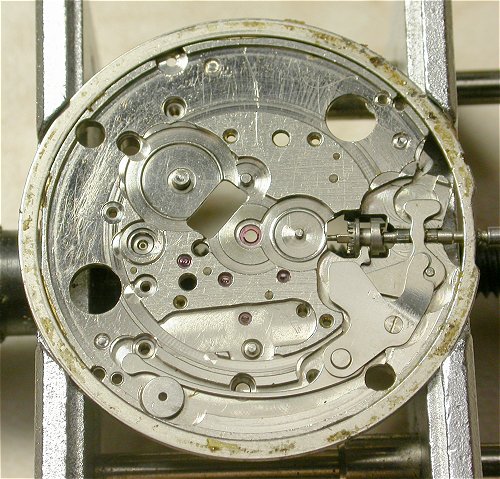 |
This is the 7005 pillar plate stripped down, except for the keyless works. The overall quality of construction of the 7005 is very good, and follows traditional watchmaking practice. As is typical with most watches, not a lot of attention is paid to finish on the dial side, the pillar plate looks like a piece of heavy machinery more than a watch movement. The straight grained surface finishes of the top plate and bridges, while not done to a high level, are neat neverthless, and shows that the company was concerned about aesthetics to some degree, though not to the same degree as the previous generation of calibres (the 6xxx series) from which this movement was derived. The Seiko calibre 7005A has 17 jewels. Up until around the 1970's, many non-Asian watch manufacturers jewelled their watches to suit the requirements of their marketing departments, often including jewels which served no purpose and which were simple and cheap to install, and omitting desirable ones. Seiko (up until the end of this generation of calibres) by-and-large jewelled their watches in a technically and functionally correct way, with only a very few exceptions. Seiko's choice of jewelling locations is no doubt another reason for the durability of their products. To see more information on watch jewelling click here. |
This is a view of the 7s26 pillar plate as a comparison. One notices immediately that the keyless works (the stem for setting the time) are not visible, as in the 7005 above, but are hidden. The overall finish of the pillar plate is neat but spartan, and the yellow brass threaded inserts pressed into the pillar plate are not plated as before. While on the subject of finish, none of the screws of the 7s26 movement have any decorative finish applied to the heads. |
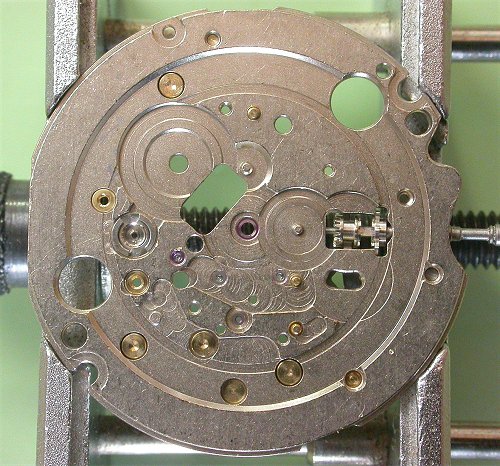 |
Here is the 7s26 pillar plate flipped over (as viewed from the back of the watch). The keyless works can now be seen. In this movement they are sandwiched between the pillar plate and the train bridge (removed). As to why they chose to do this, it is not clear to me. As far as I am aware this system is unique to the 7s26 and 7s36, and I am yet to realize any advantages in this design. Another "feature" of the 7s26 is the absence of dial screws. The dial feet press into holes in a plastic ring, which in turn clips around the edge of movement pillar plate. This black plastic ring is visible in the pic of the 7s26 calendar mechanism (3rd pic above). |
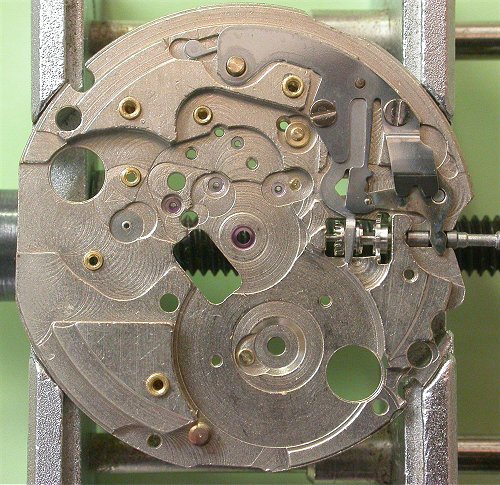 |
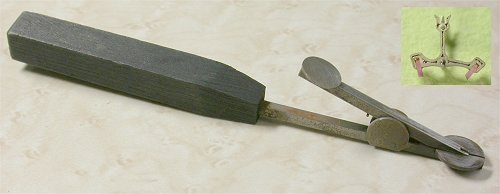 |
Now it gets more interesting. No, the strange object shown here is not a clothes peg. This is one of those odd watchmaker's tools that, unless you had to use one, you'd probably never guess it's purpose. This tool is used for re-setting pallet jewels. The pic inset show a set of fork and pallets (otherwise known as a lever). The usual examination of the watch movement during disassembly failed to reveal any problems that would cause the stopping and erratic timekeeping which this watch was apparently guilty of. But, a careful examination of the action of the escapement showed that a pallet jewel was slightly loose. This is the sort of problem we were looking for. So, the jewel has to be re-set, and this tool we see here is the right one for the job. |
Before we proceed, lets take a look at the strange-looking lever in this movement. While its overall shape is quite traditional (though Seiko's escapement design is fairly unusual by Swiss standards, being of the "semi-equidistant pallets" design), it is hollowed out in the center of the arms. Why? I believe (about 99.9% sure) that the lever has been manufactured by a "sintering process". This is a method which can be used to manufacture small components of complex shape very accurately, a watch lever being an ideal candidate. The process involves pressing metal powder under high pressure into a die to make a solid object. The item is then heated to fuse the particles together to form a solid mass. A look at the lever under the microscope shows the characteristics of typical of sintering - a fine granular appearance on all surfaces, and no machining marks visible. A look into the hollows shows the appearance of melted granules also. The guard pin and pallet staff are added later. Why make the lever hollow? Because a hollow structure (of the right proportions) is mechanically stronger than a solid one of the same size. In this case, a fraction lighter too. Seiko continue to use levers manufactured like this in the current 7S26 movements, which are descendants of this series of movements. |
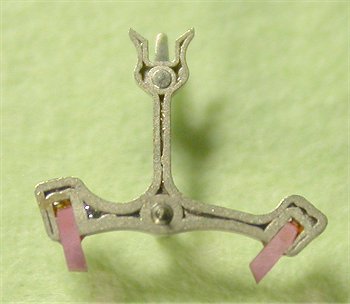 |
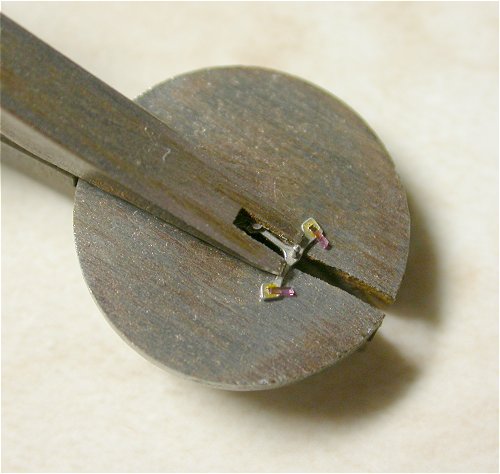 |
Getting back to the problem now....Pallet jewels are set into slots in the lever, and locked in place with a small amount of shellac on the underside. Actually, Seiko chose to use a synthetic glue, but the effect is the same. We will replace the original glue with shellac. Shown here are pallets are mounted in the tool. A small amount of shellac has been applied to the palletts, and the tool is gently heated from the underside in a small gas flame (ie cigarette lighter) to melt the shellac. A traditional watchmaker's spirit burner is better for this, as it allows both hands to be free. A small piece of shellac is used to check the temperature - if it gets too hot, the shellac will lose its adhesive properties, and will have to be cleaned off. The pallets are placed back in the movement and the position of the jewels checked by observing the locking and unlocking action of the escapement on all teeth. If not correct, they are placed back in the tool, re-heated, and the correction made. The checking process is repeated until correct. |
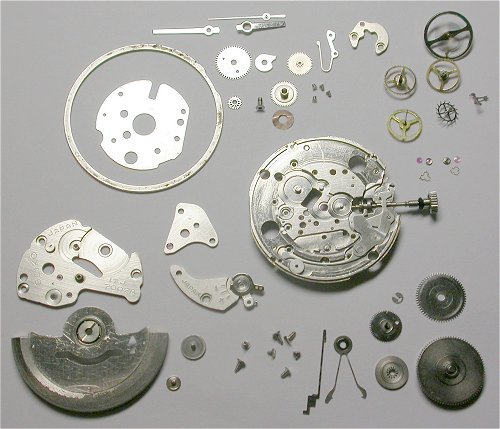 |
All repairs are done, and everything is clean. I always sort all the parts out prior to re-assembly, grouping parts according to function. All screws are sorted too, and placed with their respective groups. A lot of time can be saved and frustration avoided by doing this, even when reassembling movements one is very familiar with. Often there are only subtle differences in screw length or diameter, and later during assembly something won't fit if incorrect screws are used. |
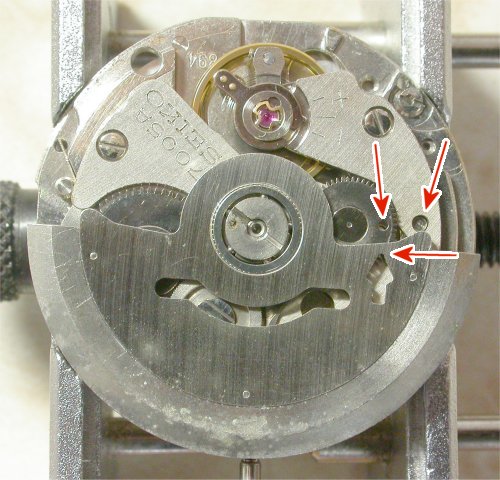 |
Ever wondered what the arrow on the Seiko auto weight is for? No, it is not for indicating winding direction, as these calibres are bi-directional winding. It is for aligning the mass of the weight with the first reduction wheel. A small hole on the first reduction wheel is aligned with a dowel pin on the balance cock, and the arrow is oriented to point to the hole on the reduction wheel. The idea is that when the watch is crown down, the eccentric on the first reduction wheel is in a "neutral" position. Equal amounts of movement in either direction of the auto weight will wind the mainspring by the same amount. Seiko engineers say this gives the best winding efficiency, and it makes sense too, since a watch generally spends a lot of time in the crown-down position (ie when you are walking). Some auto weights do not have the arrow. In this case, line up the first reduction wheel as described, then align the weight so it is centered at 3 o'clock. |
If you have persisted in reading this far, you may have reached a conclusion that I don't like the current series of 7s26 and 7s36 movements, and that they are inferior to the 7005. Well, this is not really my intention. While it is true that the quality of decorative finish on the 7s26 is not as good as previous models, it is worth noting that the same comments can be made about workhorse Swiss movements such as the Eta 2824/36, the Eta 2892, and the Valjoux 7750. These movements bear little resemblance in finish quality to their predecessors from the 1960's. I guess the bottom line is that economic necessity has forced watch manufacturers everywhere to streamline production techniques, which unfortunately can mean omitting non-essential manufacturing operations, such as the decoration of unseen parts.
From what I have seen, the 7s26 movement is a very reliable workhorse, and capable of very good performance. Their ruggedness and reliability is well-known, their basic design has been tried and proven over decades in various forms. While we now have to pay a lot more for highly finished mechanical movements, perhaps we are lucky to still have available to us very affordable mechanical watches that we can collect and enjoy.
Note 1: For a look at some of the complicated - in some cases you might even say almost bizarre - auto winding mechanisms used over the years, then the book "Complicated Watches And Their Repair" by Donald De Carle is highly recommended.